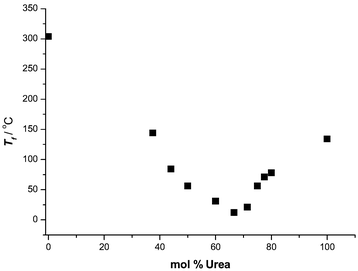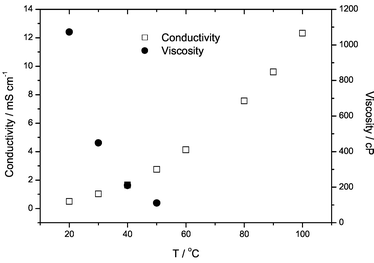Novel solvent properties of choline chloride/urea mixtures†
Andrew P. Abbott*, Glen Capper, David L. Davies, Raymond K. Rasheed and Vasuki Tambyrajah
Chemistry Department, University of Leicester, Leicester, UK LE1 7RH. E-mail: Andrew.abbott@le.ac.uk; Fax: 116 252 3789; Tel: 116 252 2087
First published on 26th November 2002
Abstract
Eutectic mixtures of urea and a range of quaternary ammonium salts are liquid at ambient temperatures and have interesting solvent properties.
Eutectic mixtures of salts have been utilised for a long time to decrease the temperature for molten salt applications. In the extreme, ambient temperature molten salts have been formed by mixing quaternary ammonium salts with metal salts. This type of ionic liquid can be viewed as a deep eutectic resulting from the formation of complex anions e.g. Al2Cl7− and Zn2Cl5− thus decreasing the lattice energy and decreasing the freezing point of the system. Work in this area focussed on chloroaluminate salts of imidazolium and pyridinium chloride. A variety of different anions are formed in solution the ratios of which vary with the changing aluminium chloride composition.1–3 These ideas have recently been extended to other chlorometallate salts including ZnCl2, SnCl2 and FeCl3.4,5
Halide salts can also form complexes with hydrogen bond donors and previous work has shown that mixtures of urea with alkali metal halides form eutectics with melting points of <150 °C.6,7 While a few reports also exist for adducts of urea with other metal salts8,9 their use as solvents has been limited to high temperature applications.10 In the current work we show that mixtures of substituted quaternary ammonium salts such as hydroxyethyltrimethylammonium (choline) chloride with urea produce eutectics that are liquid at ambient temperature and have unusual solvent properties. Fig. 1 shows the freezing point of mixtures of choline chloride and urea. A eutectic occurs at a urea to choline chloride ratio of 2. The freezing point of the eutectic mixture is 12 °C, which is considerably lower than that of either of the constituents (mp choline chloride = 302 °C and urea = 133 °C) and allows the mixture to be used as an ambient temperature solvent. This significant depression of the freezing point must arise from an interaction between urea molecules and the chloride ion. This is consistent with the crystallographic data for the solid adduct [(CH3)3N+CH2CH2OH]2C2O42−·2(NH2)2CS which shows extensive hydrogen bonding between the thiourea molecule and the oxalate anion.11 Previous work12 has also shown that the stable adduct Pr4N+Cl·2(NH2)2CO can be isolated although this has a melting point of 160 °C. The existence of hydrogen bonding in these eutectic mixtures can be observed using NMR spectroscopy. HOESY spectra of HOCH2CH2N+(CH3)3F−·2(NH2)2CO show intense cross-correlation between the fluoride ion and the NH2 protons on the urea molecule. FAB-MS which was run neat on a 1 choline chloride∶2 urea mixture without a matrix showed the presence of Cl− with two ureas (M− = 155) and Cl− with one urea (M− = 95).
 | ||
| Fig. 1 Freezing point of choline chloride/urea mixtures as a function of composition. | ||
Table 1 lists the freezing temperature, Tf, of a variety of amide compounds mixed with choline chloride in a 2∶1 mole ratio. It is noticeable that only those compounds capable of forming hydrogen bonds with chloride ions demonstrate the formation of a homogeneous liquid with a significant decrease in the freezing point compared to the pure amide. It can also be seen that the amides with greatest ability to form hydrogen bonds (i.e. urea and thiourea) exhibit the largest depression in freezing point when mixed with choline chloride. Comparisons can be drawn between this type of solvent and the lithium perchlorate/ diethyl ether system, although naturally in the latter case the complex is formed with the cation and the ether is a liquid at ambient temperatures.13
This method of forming ambient temperature liquids is not limited to choline chloride and Table 2 lists the freezing points of mixtures formed between a variety of quaternary ammonium salts with urea. It is shown that as the symmetry of the cation is decreased the melting point of the mixtures decreases which is analagous to ionic liquids.1,4 Furthermore, a wide variety of functional groups can be used and the principle also works for other monovalent anions (e.g. NO3−, BF4−) that are capable of forming hydrogen bonds. Table 2 shows that the freezing point of choline salts with urea decrases in the order F− > NO3− > Cl− > BF4− suggesting some correlation with hydrogen bond strength.
| R1 | R2 | R3 | R4 | X− | Tf/°C |
|---|---|---|---|---|---|
| C2H5 | C2H5 | C2H5 | C2H5 | Br | 113 |
| CH3 | CH3 | CH3 | C2H4OH | Cl | 12 |
| CH3 | CH3 | CH3 | C2H4OH | BF4 | 67 |
| CH3 | CH3 | CH3 | C2H4OH | NO3 | 4 |
| CH3 | CH3 | CH3 | C2H4OH | F | 1 |
| CH3 | CH3 | PhCH2 | C2H4OH | Cl | −33 |
| CH3 | CH3 | C2H5 | C2H4OH | Cl | −38 |
| CH3 | CH3 | CH3 | PhCH2 | Cl | 26 |
| CH3 | CH3 | CH3 | C2H4OAc | Cl | −14 |
| CH3 | CH3 | CH3 | C2H4Cl | Cl | 15 |
| CH3 | PhCH2 | C2H4OH | C2H4OH | Cl | −6 |
| CH3 | CH3 | CH3 | C2H4F | Br | 55 |
These fluids exhibit unusual solvent properties that are strongly influenced by hydrogen bonding. In general, compounds capable of donating or accepting electrons or protons to form hydrogen bonds show high solubilities. For example, in a 1 choline chloride∶2 urea mixture at 50 °C high solubilities are observed for inorganic salts (e.g. LiCl > 2.5 mol dm−3), salts that are sparingly soluble in water (e.g. AgCl solubility = 0.66 mol dm−3), aromatic acids (e.g. benzoic acid solubility = 0.82 mol dm−3) and amino acids (e.g. D-alanine solubility = 0.38 mol dm−3). Also, because these liquids have a high anion concentration they dissolve several metal oxides e.g. solubility of CuO = 0.12 mol dm−3. Analogous properties are observed for other mixtures in Tables 1 and 2. These are unusual solvent properties when compared to most molecular solvents and are more typical of the properties observed for ionic liquids.
Similarly for biphasic studies and extraction processes it is easy to predict the solvents that are miscible with these IMLs. Solvents capable of forming strong hydrogen bonds with a chloride ion tend to be miscible, e.g. ethanol, water and methanol, and those that cannot are immiscible, e.g. acetone, acetonitrile, acetophenone, dichloroethane, diethylether, ethylacetate, hexane, propylene carbonate, and toluene.
These deep eutectic solvents are highly conducting (ca. 1 mS cm−1 at 30 oC), confirming that the ionic species are dissociated in the liquid and can move independently. Fig. 2 shows that the conductivity increases significantly with temperature.‡ The values are comparable to those for most imidazolium based ionic liquids1 and an order of magnitude larger than for the choline chloride–zinc chloride system previously studied.4 The viscosity and conductivity are strongly affected by the amide and quaternary ammonium salt and hence the fluid properties could be tailored for specific applications.14
 | ||
| Fig. 2 Conductivity and viscosity of a 2∶1 urea∶choline chloride mixture as a function of temperature. | ||
This work has shown that mixtures of amides with quaternary ammonium salts form low melting point eutectics that have unusual solvent properties. Additional advantages of this type of mixture is that it is sustainable, biodegradable and a large number of variants can be produced from readily available materials.
The authors would like to acknowledge Scionix Ltd. for funding this work and Dr Gregor Rozenberg for helpful discussions.
Notes and references
- T. Welton, Chem. Rev., 1999, 99, 2071 CrossRef CAS.
- P. Wasserscheid and W. Keim, Angew. Chem., Int. Ed., 2000, 39, 3772 CrossRef.
- M. J. Earle and K. R. Seddon, Pure Appl. Chem., 2000, 72, 1391 Search PubMed.
- A. P Abbott, G. Capper, D. L Davies, H. Munro, R. K Rasheed and V. Tambyrajah, Chem. Commun., 2001, 2010 RSC.
- M. S. Sitze, E. R. Schreiter, E. V. Patterson and R. G. Freeman, Inorg. Chem., 2001, 40, 2298 CrossRef CAS.
- M. Gambino and J. P. Bros, Thermochim. Acta, 1988, 127, 223 CrossRef CAS.
- M. Gambino, P. Gaune, M. Nabavian, M. Gaune-Escard and J. P. Bros, Thermochim. Acta, 1987, 111, 37 CrossRef CAS.
- W. G. McGavock, J. M. Bryant and W. W. Wendlandt, Science, 1956, 123, 897 CAS.
- P. S. Gentile and L. H. Talley, J. Am. Chem. Soc., 1957, 79, 4296 CAS.
- L. Z. Liu, Y. X. Tong and Q. Q. Yang, Rare Met., 2000, 19, 237 Search PubMed.
- S. Saito, M. Lee and W. Y. Wen, J. Am. Chem. Soc., 1966, 88, 5107 CrossRef CAS.
- Q. Li and T. C. W. Mak, Cryst. Eng., 1998, 1, 169 Search PubMed.
- W. Herbert, Angew. Chem., Int. Ed. Engl., 1991, 30, 1306 CrossRef.
- More details of applications of these liquids are given in: A. P Abbott, G. Capper, D. L Davies, R. K Rasheed and V. Tambyrajah, PCT Int. Appl., 2002, WO 0226701.
Footnotes |
| † Electronic supplementary information (ESI) available: spectroscopic data. See http://www.rsc.org/suppdata/cc/b2/b210714g/ |
| ‡ Viscosity was determined using a Brookfield DV-E viscometer and conductivity was measured using a Jenway 4071 conductivity meter. The quaternary ammonium salts were synthesised by the same general method. Into a Schlenk tube was typically placed 30 mmol of haloalkane which was frozen in liquid-N2. The tube was then evacuated and an excess of Me3N (50 mmol) added and the sample refrozen in liquid N2. The tube was then allowed to thaw in a dry-ice bath until reaching room temperature. The unreacted Me3N was evaporated and any unreacted haloalkane removed under vacuum from the white solid which was obtained >60% yield. All quaternary ammonium salts were recrystallised from ethanol and then rigorously dried under vacuum prior to use. The amides were obtained from various sources all >99% purity and were dried under vacuum prior to use. The mixtures were formed by heating the components to 80 °C and stirring until a homogeneous liquid was formed. The compounds were characterised using ir, nmr and mass spectroscopy. (See ESI†). The liquids were found to be homogeneous mixtures of the two components i.e. no covalent bonds were formed via side reactions. Since the mixtures are hydroscopic they will spontaneously adsorb water but under the measurement conditions the samples studied were found to contain less than 1 wt% water (using nmr spectroscopy). |
| This journal is © The Royal Society of Chemistry 2003 |
